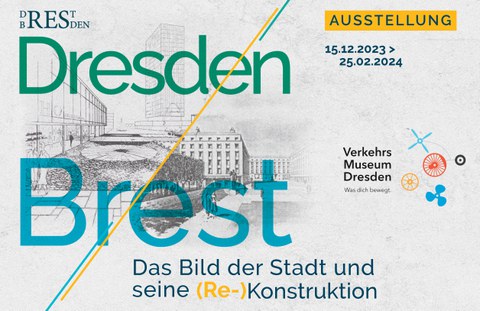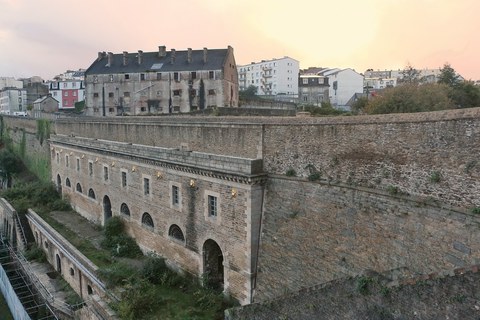Dec 20, 2023
Double exhibition of the EU project Res Urbanae: Dresden - Brest: The image of the city and its (re)construction

Projekt RES URBANAE
TUD partner of the double exhibition of the EU project Res Urbanae:
16 December 2023 - 25 February 2024
Verkehrsmuseum Dresden, Augustusstraße 1
Tuesday - Sunday 10am - 6pm
15 December 2023 - 10 February 2024
Zentrum für Baukultur Sachsen, Schloßstraße 2
Tuesday - Saturday 1pm - 6pm
Background / About the Res Urbanae project
The project "Res Urbanae - Perspectives on Cities in Reconstruction", funded by the EU for the period 2022-2024, is related to the current building and planning processes in two cities - Dresden in Germany and Brest in France - whose history points in the same direction from a certain point onwards: they were destroyed by the bombing raids of the Second World War and subsequently rebuilt in a completely different form and according to the respective possibilities of temporal realisation. This exhibition uses the comparative history of the two cities to show how urban visual and imaginary worlds are constructed and reconstructed. The cities are thus the starting point for a reflection on the concept of reconstruction and on how the destruction that hit the urban area subsequently triggered creative processes - be it in the field of architecture, urban planning or art.
The EU project Res Urbanae comprises several elements spread over the two-year duration of the project: A design workshop for architecture and urban planning students (Brno, November 2022), an international scientific colloquium on Reconstructed Cities - Cities under Reconstruction (Brest, January 2023), a double artist-in-residence programme (in Brest and Dresden, January-February 2023), small thematic exhibitions by students, the large travelling exhibition (June to September 2023 in Brest, December 2023 to February 2024 in Dresden, April/May 2024 in Brno, followed by further exhibition venues) and a comprehensive final publication (to be published in May 2024).
Website: www.res-urbanae.eu and social networks (Facebook, Instagram)
The actors / organisers of the project
The project was initiated jointly by the University of West Brittany UBO (Institute of Geoarchitecture), the Technical University of Dresden (Faculty of Architecture), the Technical University of Brno (VUT - Faculty of Architecture) and the German Cultural Institute in Brest (Maison d'Allemagne Finistère, MdA).
The Res Urbanae project is funded by the EU's Creative Europe programme.
With a budget of 2.44 billion euros, the Creative Europe programme is a flagship programme of the European Union. It comprises investments in measures aimed at strengthening cultural diversity and addressing the needs and challenges of the cultural and creative sectors.
The main objectives of the programme are
- Preserving, developing and promoting European cultural and linguistic diversity and the European cultural and linguistic heritage
- Increasing the competitiveness and economic potential of the cultural and creative sectors, especially the audiovisual sector.
The travelling exhibition
Introduction
This exhibition uses the comparative history of two cities - Brest (in France) and Dresden (in Germany) - to illustrate how urban visual worlds and identities are constructed and reconstructed.
Historically, Brest, a royal military base facing the sea, and Dresden, the residential city of the electors and kings of Saxony, stood in marked contrast to each other, but in their almost complete destruction during the bombing raids of the Second World War, they shared a common destiny. Since then, Dresden and Brest have faced the ultimately identical challenge of fundamental reconstruction. Each of the two cities conveys a certain image of itself, defined by the historical buildings, the destruction and the reconstruction that characterise the urban area. In this exhibition, realised projects and those that have remained dreams are compared with each other. The concept of utopia is also examined, as it has repeatedly generated exciting ideas and approaches.
Brest and Dresden are two cities with strong identities. With the exhibition, we offer to travel through three centuries and compare the developments of the two cities, with the aim of finding the convergences in the dissimilarities and the divergences in the similarities.
We hope that every visitor will find an echo of their own city beyond Dresden and Brest, and the way in which solutions are found to the problems that characterise our shared European history.
Structure of the exhibition
The exhibition is conceived as a continuous juxtaposition of the two cities. It is divided into four sections:
The first section (From urban beautification to urban planning) offers a detailed description of the urban development of the two cities from the 18th century to the Second World War.
The second section (The Shock of History: Images of Destruction) briefly recalls the period from 1939 to 1945, the tragic time of the Second World War, when both cities were bombed and destroyed.
The third section is entitled At the Gates of Utopia: it shows reconstruction scenarios from three decades, which have manifested themselves on site according to quite different, but for each city characteristic chronological sequences.
The last section (Deconstruction of Utopia) looks at the last decades of the 20th century and opens up a view of the present and the near future: questioning and reorientation are addressed here.
The exhibition was created to travel through Europe and make stops in as many places as possible: it shows reproductions of works from museums and archive materials of very different kinds: paintings, prints, photographs, plans, films, etc.
A special place will be given to contemporary artists (from France and Germany) in order to emphasise the importance of artistic imagery in the processes of urban reconstruction. Resilience and creativity are thus equally at the centre of the Res Urbanae project.
Another important part of the exhibition is the work Converging Visions, which emerged from the artist-in-residence programme of the Res Urbanae project. It is a work created especially for the exhibition by Austrian composer Ivana Radovanovic: a sound composition that crosses the acoustic worlds of the two cities and is integrated into the exhibition in such a way that it invites the public to participate.
Accompanying programme to the exhibition
16.12.2023, 7 pm, Centre for Building Culture Saxony
Converging Visions
Ivana Radovanovic, composer, Graz
18.01.2023, 7 pm, Centre for Building Culture Saxony
Artist lecture
Jahna Dahms, freelance artist, Dresden
20.01.2023, 7 pm, Centre for Building Culture Saxony
"Saxony's distant neighbour: Brittany - Land by the sea between Celtic heritage and the French present"
Prof Dr Ingo Kolboom, Dresden University of Technology,
Former President of the Saxon-Breton Society
08.02.2023, 7 pm, location to be announced
Film: What remains - post-war modernist architecture in Dresden,
Director: Ralf Kukula, 2009
23.02.2023, 7 pm, location to be announced
Panel discussion: Urban visions and urban identity
Dr Matthias Lerm,
Office for Urban Planning and Mobility of the City of Dresden
Marco Dziallas,
State Office for Monument Preservation Saxony
Dr Marcus van Reimersdahl,
Saxon State Ministry for Science and the Arts
Moderation:
Prof Dr Hans-Georg Lippert, Dresden University of Technology
25.02.2023, 4 pm, Transport Museum
Finissage with curator tour
Free admission to all events in the accompanying programme.
Admission to the exhibition itself is free on the following Fridays:
05.01., 12.01., 19.01., 26.01., 02.02., 09.02.2024
Curators of the exhibition
Sonia de Puineuf & Hans-Georg Lippert, in collaboration with Daniel Le Couédic, Amandine Diener, Patrick Dieudonné and Kerstin Zaschke
Scenography and graphic design
The scenography of the exhibition was designed by ATIZ (Pauline Lavergne) in collaboration with graphic designer Pauline Gaucher Loaëc. It consists of wooden shelving elements and cardboard boxes arranged to create half-closed and half-open spaces. The production is carried out by 47NOORD. The visual leitmotif of the exhibition was also designed by Régine Gaucher Loaëc.
The exhibition panels are written in three languages: German, French and English. In addition, around 50 images are labelled with a QR code that leads to further detailed explanations in German, French, English and Czech.
And one more hint:

Pontaniou Prison in Brest
The exhibition in the Transport Museum is complemented by a second, smaller exhibition in the Centre for Building Culture Saxony (Kulturpalast). Entitled "Res Urbanae - Views of Cities under Reconstruction: Brest and Dresden", it will be showing work by students from the universities involved in the EU project Res Urbanae on the history and reconstruction as well as projects for the future of urban districts in Brest from 15 December 2023 to 10 February 2024.
Contact us
(curators of the exhibition) (request for image material)